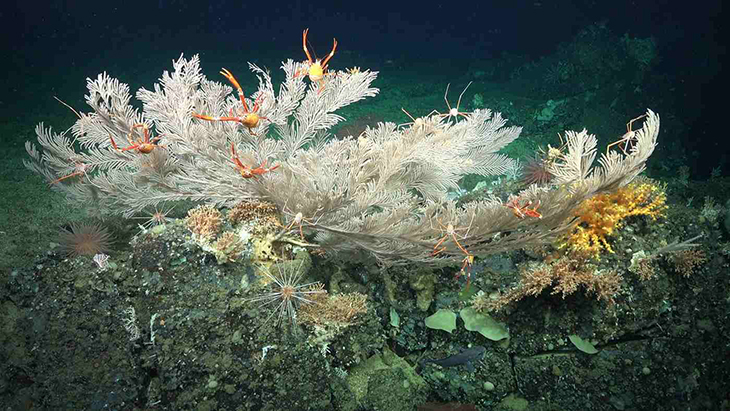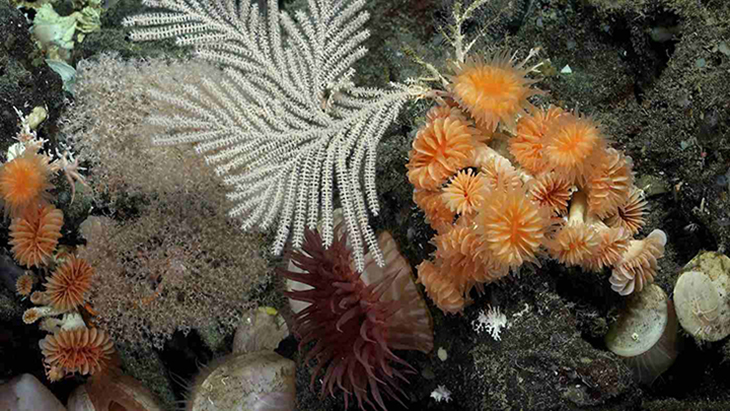
The renowned biodiversity of the Galápagos Islands is not confined to the terrestrial realm, as a recent deep-water expedition has unveiled the hidden wonders beneath the giant tortoises’ stomping grounds.
Led by the Schmidt Ocean Institute, an international team embarked on a groundbreaking journey that uncovered two pristine cold-water coral reefs flourishing in the depths, a discovery that expands our understanding of marine ecosystems.
Unlike tropical coral reefs, which predominantly thrive within 120 feet of the surface, these newly discovered cold-water corals were found at staggering depths ranging from 1,200 to 1,375 feet (370 to 420 meters).
Referred to as “stony corals,” these deep-sea marvels were nestled alongside the walls and bases of seamounts, creating an awe-inspiring underwater spectacle. The larger of the two reefs stretched over 800 meters, equivalent to eight football fields, while the second, though smaller at 250 meters, was equally impressive.
The rich diversity of stony coral species observed in these reefs suggests that they have likely been evolving and supporting marine life for thousands of years. The inhabitants of this deep-sea ecosystem included sea fans, also known as Gorgonians, and stony corals from the subclass Hexacorallia, commonly referred to as six-sided corals.
Notably, these findings mark the second and third instances of deep-sea coral reefs discovered in the Galapagos Island Marine Reserve, with the first one having been identified just months earlier by scientists from the Woods Hole Oceanographic Institution.
Dr. Katleen Robert of the Fisheries and Marine Institute of Memorial University of Newfoundland and Labradorspearheaded the Schmidt expedition, which comprised 24 scientists from 13 organizations and universities.
Over the course of 30 days, the team utilized advanced laser scanning technology to generate incredibly high-resolution maps of the reefs and seamounts, achieving an unprecedented 2-millimeter resolution.
Danny Rueda Córdova, director of the Galápagos National Park Directorate said, “This information is not only valuable from a scientific perspective, but it also provides a solid foundation for decision-making that effectively protects these ecosystems, safeguarding the biological diversity they harbor and ensuring their resilience in a constantly changing environment.”

The scientific exploration extended beyond the Galápagos Islands to the Isla del Coco National Marine Park, a protected area managed by Costa Rica. Venturing southwest of Isla del Coco, the researchers delved into the connections between coral communities on seamounts in both the Galápagos and Costa Rica.
During a remotely-operated submersible dive, they were astounded to witness multiple deep-sea coral species laden with eggs, providing valuable insights into the reproductive dynamics of these enigmatic ecosystems.
Aside from the marvels of coral biodiversity, the research conducted during this expedition contributes crucial data to the management of the Eastern Tropical Pacific Marine Corridor. This vast network of interconnected marine reserves, overseen by the governments of Ecuador, Costa Rica, Panama, and Colombia, serves as a cornerstone for conservation efforts in the region.
Charles Darwin Foundation’s CEO, Stuart Banks, said, “The Galápagos Marine Reserve is an area of outstanding biological importance, connected to partner marine protected areas across the Eastern Pacific. Finding such deep and long-lived reef takes us important steps closer to protecting hidden dimensions of ocean diversity and understanding the role that deep habitats play in maintaining our ocean’s health.”
“These fascinating new findings continue to feed important research to inform better management of existing and future marine protected areas in the region,” he adds.
By shedding light on the intricate relationships between deep-sea ecosystems, the scientists aim to inform and guide the sustainable management of these vital marine habitats. The significance of this research extends far beyond the depths of the Galápagos Islands, resonating in the broader context of marine conservation and ecological understanding in the Eastern Tropical Pacific.
What are your thoughts? Please comment below and share this news!
True Activist / Report a typo


